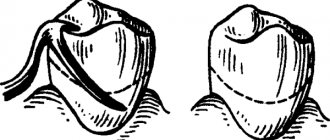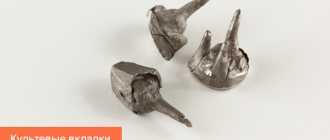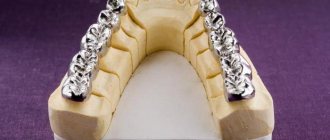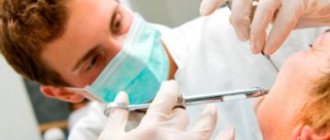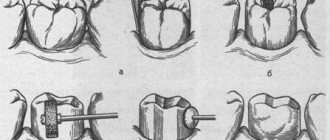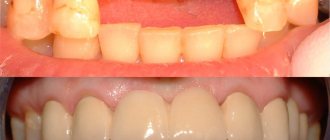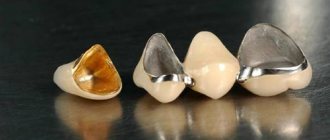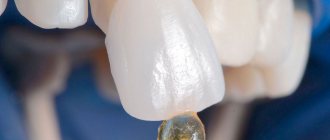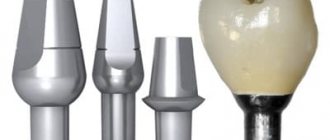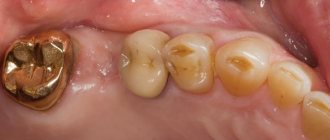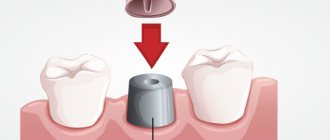A beautiful smile is the dream of every person, and it’s good when it’s natural, but this is becoming less and less common. Under the influence of many negative factors, such as the environment, nutrition, hygiene, injuries, the problem of missing several teeth occurs in many people. Removable dentures come to the rescue. They are attached to existing teeth with clasps. What kind of devices are these, what types are there and what harm can they cause?
Concept and structure of clasps
Clasps are special clamps with which a removable denture is attached to the teeth. In addition, these clamps distribute the chewing load evenly over the entire surface of the jaw.
They consist of the following elements:
- Shoulder. The part that covers the tooth, in turn, is divided into supporting (maintains rigidity and prevents lateral movement) and retaining (provides fixation of the prosthesis).
- Body. The spring base of the clamp, connecting all its fragments and located on the contact surface of the crown.
- Process. Designed for attaching the lock to the prosthesis frame.
The support-retaining fixture also contains an occlusal pad, which allows you to hold the tooth without displacement under the action of angular force. There is also an anchor part with which the clamp is connected to the metal frame.
READ ALSO: how and why are dental veneers used?
What is a clasp?
The clasp is an integral part of a removable denture and looks like specific hooks. Its purpose is to hold the denture. The fixing structure itself is assembled from several parts:
- Occlusal overlay – helps distribute the load on the supporting dental units.
- The body is a stationary area located closer to the upper pole of the chewing element. Connects all components.
- Shoulder – gives a springing effect when the denture is displaced, covers the area of the dental crown. Contains a supporting part (prevents movement to the side, imparts rigidity) and a holding part (fixing action).
- Process - connects the fixing part with the prosthesis, often covered with a base or crowns.
The task of clasps is to fix the prosthesis.
To use the clasp system, you must have your own chewing elements that will serve as a support. Primary requirements:
- Sustainability.
- Functional relationship to the opposing unit of the other jaw arch. The components of the fixation will make the bite higher in the case of natural close contact during chewing or closing of the jaws.
- Classic anatomical shape. Selection with a non-standard configuration is quite risky and impractical.
- Full treatment.
Selecting a clasp system is not an easy task for a dentist. The installation is considered successful if:
- The bite does not increase.
- Rotational movements of the denture are excluded.
- The load is evenly distributed among all support units.
- The components of the retainer are practically invisible or completely invisible.
Clasps for dentures are made from wire or by casting.
The condition for strong attachment is the presence of strong supporting teeth.
Classification: types and features of clasps
Fixators are different depending on the prosthesis, material, and functions performed. The most popular clamps include:
- Bonneville. It consists of two onlays that are fixed in the fissures of molars and premolars. They are used for unilateral missing teeth.
- Jackson. Reversible design, which is a loop. Can be cast or wire.
- Dentoalveolar. Made of plastic, reinforcement possible. It is used when it is necessary to achieve an aesthetic effect.
- Round one-shoulder. They are usually folded onto the molars.
- Schwartz. It bends out of the orthodontic wire and occupies the interdental space. It can be single-link or multi-link.
- Adams. A button lock, consisting of two fixing protrusions, curved towards each other, and two bodies, on the inside turning into processes.
- Duisings. It is bent like a Jackson clasp, but has two semicircular bends at the shoulder, two bodies and two appendages.
- Reichelman. It differs from others in the shape of the lining, which looks like a transverse bar, which goes through the chewing surface into the inside of the oral cavity.
Fixing elements of orthodontic devices
Golovko Nonna Vasilievna , Associate Professor of the Department of Propaedeutics, Orthopedic Dentistry and Orthodontics of the Ukrainian Medical Dental Academy.
Fixation is the strengthening of the orthodontic apparatus or denture on the jaw in static conditions, and stabilization is the stability of the orthodontic apparatus or denture during functions (speech, chewing, swallowing).
One of the most common methods of fixing removable orthodontic appliances and dentures is the use of fixing devices, which include:
- Clasps.
- Crowns or rings.
- Mouthguards.
- Combined fixation according to M.A. Napadov (dentoalveolar or dentogingival).
A clasp (from German – klammer – hook) is a special device that is designed for attaching the base of a removable orthodontic appliance or denture to the teeth.
Clasps are classified as follows:
I. By location: dental, gingival (pelota), dentogingival;
- Clasps using the subequator tooth space: - single-arm round bent clasp,
- - Jackson flip clasp,
- - Duisings clasp,
- - Adams clasp,
- - frame clasp,
- - tape clasp.
- - Schwartz arrow-shaped clasp,
II. According to the nature of contact between the clasp arm and the tooth crown:
- Group 1 – clasps with a plane contact of the shoulder to the tooth crown (bent and cast tape clasps). Clasps of this group have a large surface of contact with the crown of the tooth and sometimes lead to abrasion of the enamel and make it difficult for the teeth to self-clean from food debris, which can lead to the development of caries. They are also imperfect from an aesthetic point of view. The fixing effect is achieved by increasing the plane of contact of the clasp arm to the tooth and the force of its pressing. However, the latter increases the load on the supporting tooth.
- Group 2 – clasps with a linear contact of the shoulder to the tooth crown. This group consists of the following clasps: round single-arm bent clasp, Jackson flip clasp, Duisings clasp, frame clasp and others. Such clasps have sufficient elasticity because they are bent from round elastic orthodontic wire. The improvement in the fixing effect in the Jackson reversible clasp and the Duisings clasp in comparison with the round single-arm bent one is explained by the increase in the area of contact between the shoulder and the body of the clasp to the tooth. They are less noticeable to others.
- Group 3 – clasps with a point contact to the tooth crown. This group consists of the following clasps: button, spear-shaped, hook-shaped, arrow-shaped Schwartz and Adams clasp. They have greater elasticity because they are bent from thinner orthodontic wire. These clasp designs optimally solve basic problems and provide fixation of removable orthodontic appliances and dentures. They are hardly noticeable.
In comparison with clasps of groups 1 and 2, clasps of group 3 minimally injure the tooth enamel, since they contact the tooth surface pointwise, that is, over a small area.
III. Shape: (round, semicircular, flat or ribbon).
IV. By manufacturing method: (bent and cast).
V. According to the degree of coverage of a tooth or several teeth: (single-armed, double-armed, ring-shaped or reversible, double and multi-linked).
VI. By function: (retaining and support-retaining). Retaining clasps are intended exclusively for fixing removable orthodontic appliances and dentures. With these types of clasp fixation, the vertical chewing load is completely transmitted through the base to the mucous membrane. Support-retaining clasps of clasp dentures and orthodontic clasp appliances not only fix, but also make it possible to distribute the chewing load between the mucous membrane of the prosthetic bed and the periodontium of the supporting teeth.
VII. According to the material from which the clasps are made: steel, gold, plastic.
VIII. According to the method of connection with the base or in relation to the body and shoulder of the clasp: rigid or stable, springy or semi-labile, articular or labile.
IX. Depending on the number of teeth used for fixation: point fixation - use of 1 single-arm clasp, linear - use of two single-arm clasps, planar - use of more than 3 single-arm clasps.
Retaining clasps, which are most widely used in orthodontic practice, consist of a shoulder, a body and a process.
The clasp arm is its elastic part, which covers the crown of the abutment tooth. Its location is determined by the anatomical shape of the tooth. In practical dentistry, it is customary to divide the surface of the tooth crown into 2 parts: occlusal and cervical. The boundary between them is the equator, that is, the line that runs along the most convex part of the tooth. The clasp arm provides fixation of a removable orthodontic appliance or denture. Crossing the belt of the supporting tooth, it is tightly pressed against the gingival part, which has the smallest diameter.
When making the arm of a retaining clasp, you must remember the following requirements:
- The shoulder should cover the tooth from the labial or buccal side, located directly behind the line of greatest convexity, that is, between the equator and the gum.
- The clasp arm, round or flat, should touch the tooth surface at as many points as possible. The fit at only one point leads to a sharp increase in pressure during movements of the base of the prosthesis or apparatus and leads to abrasion of the enamel.
- The shoulder should be elastic when the base shifts. Not all clasps have this quality. Wire clasps are the most elastic, cast ones are less flexible. Unlike bent wire clasps, cast clasps more accurately follow the relief of the tooth surface.
- The shoulder should be passive, that is, not transfer pressure to the supporting tooth.
- The shoulder must be rounded and polished to prevent injury to the buccal mucosa.
The clasp body is its stationary part, which is located above the equator of the abutment tooth on its contact side. It should not be placed below the equator (near the neck of the tooth), since in such cases the clasp interferes with the application of the prosthesis or orthodontic apparatus. On the front teeth, from an aesthetic point of view, this rule can be abandoned by placing the body of the clasp closer to the gingival margin.
The clasp extension is designed for attaching the clasp to the base of a prosthesis or orthodontic apparatus. It should be 0.5-0.7 mm away from the mucous membrane.
The clasps are placed in the orthodontic appliance or denture in such a way that they do not interfere with the rotation of the base.
Clasp fixation is called point fixation if it is located in one area (on one tooth). Fixation in which the clasps can be connected by a line is called linear. The location of the clasps at three or more points allows them to be combined along a plane, which is why such fixation is called planar. This type of fixation is more reliable. The reliability of fixation depends not only on the number of clasp points, but also on their relative position in relation to the midline of the alveolar arch. The conditional line that connects 2 clasps is called a clasp line. It can cross the midline of the alveolar process at an angle that is close to straight; cross it diagonally or run parallel to it on one or both sides. Thus, clasp lines can have a transversal, diagonal or sagittal direction.
To fix a removable orthodontic appliance or prosthesis on the lower jaw, it is advisable to place the clasps along the transversal, as they will counterbalance the lifting of the base by the muscles of the tongue and floor of the mouth.
To fix a removable orthodontic appliance or prosthesis on the upper jaw, it is better to use a diagonal arrangement of clasps, since the diagonal clasp line crosses the midline of the alveolar process and the fixing effect of the clasps extends to both halves of the prosthesis.
The choice of fixing elements depends on:
- presence of teeth and interdental contacts,
- group affiliation of the tooth,
- tooth crown height,
- expressiveness of the equator,
- presence (severity) of the vestibular subequatorial space,
- depth of the vestibule of the oral cavity,
- the presence of space between the upper and lower teeth in a state of central occlusion.
Single-arm round bent clasp:
It is the easiest to manufacture and ensures good stability of the apparatus if it is placed taking into account the direction of the acting forces and is manufactured in sufficient quantity. The choice of abutment teeth is associated with the location of the clasp lines.
Place a single-arm round curved clasp on the lateral teeth (2-3 on each side of the dentition). It is bent from orthodontic wire with a diameter of 0.6-0.8 mm (0.6 mm wire for temporary teeth, and 0.8 mm for permanent teeth). It covers the tooth in the subequatorial space. If it is made on the last distally located tooth, then it should not cross the interdental occlusal space.
A single-arm round bent clasp consists of a shoulder that covers the tooth from the vestibular side; body - the middle, or elastic part, which connects the clasp arm with the process and the process, which is welded into the base of the orthodontic apparatus or denture.
Such a clasp covers the tooth only on one side and performs only the function of holding. Since the clasp is firmly fixed in the base, its shoulder has a constant elastic action.
The clasp on the tooth is placed strictly in relation to the equator. On the teeth of the upper jaw, the clasp arm is located above the equator, on the teeth of the lower jaw - below, which ensures that the arm slides along the convexity of the tooth crown when fixing the apparatus. The height of the clasp should be determined taking into account the closure of the dentition so that it does not interfere with the movements of the lower jaw. The larger the elastic part of the clasp, the more elastic it is and the less harmful the effect it has on the supporting tooth.
A single-arm round bent clasp can be made elongated and cover the tooth located in front. But this does not lead to a significant improvement in the retention effect.
If it is necessary to use both a plate apparatus and rings on molars with locks and tubes to fix extraoral traction, a single-arm clasp is located under the lock and tube.
If there are defects in the dentition, it is possible to manufacture a round, double-armed clasp, in which one arm covers the tooth from the vestibular surface, and the other from the oral surface. Both shoulders are united using a body, which is placed in the area of the defect. It is advisable to use such a clasp design in the manufacture of removable orthodontic appliances, which also perform the function of replacing dentition defects.
Such a clasp can be bent from one piece of wire with a diameter of 0.6 mm or made up of two single-arm clasps.
Ear-shaped clasp - also bent according to the principle of making a single-arm round bent clasp, but at the end of the shoulder there is a curve in the form of an auricle. The ear-shaped clasp can be made multi-link.
The Jackson flip-over clasp has two bodies and two branches. This type of clasp is called combined due to the creation of elements of resistance and the transfer of pressure to the crowns of the teeth. To make a clasp, orthodontic wire with a diameter of 0.8-1.0 mm is used.
The Duisings clasp (Fig. 17) has 2 semicircular bends on the shoulder, which enhances its elasticity, elastic properties and fixation. For its manufacture, orthodontic wire with a diameter of 0.5-0.6 mm is used.
A necessary condition for using the Duisings clasp is a sufficient height of the crowns of permanent teeth.
Rice. 17. Duisings clasp.
The frame clasp differs from the designs described above in that its shoulder covers a group of teeth. The retaining part – the frame – is placed on the vestibular surface of the lateral teeth. It presses the teeth against the base of the apparatus and does not slide on the latter, since the equator of the supporting teeth prevents this. The part of the frame that is located in the area of the alveolar process should lag behind the mucous membrane by 0.5 mm and not reach the transitional fold.
Frame clasps are indicated during the period of teeth change. The loss of a temporary tooth does not weaken the fixation of the device, since the clasp rests on several teeth. Frame clasps are convenient in cases where the equator of primary teeth is well defined.
Tape clasps are rarely used in the manufacture of orthodontic structures, mainly for retention of the location of anterior teeth after their rotation around an axis or mesio-distal movement. In the latter case, the clasp on the vestibular surface of the tooth is shortened and left in the form of a barely noticeable paw. To make a tape clasp, use a flat steel tape 1.5-2 mm wide and 0.3-0.4 mm thick. It can also be made from round orthodontic wire with a diameter of 0.9-1.0 mm, if it is flattened using rollers or a hammer. The clasp is placed between the teeth, so in some cases it is necessary to engrave plaster teeth on the model.
Button clasp - made from standard orthodontic wire blanks with a diameter of 0.6 to 1.0 mm, at the end of which there is a drop-shaped extension. It is used in the presence of tight contacts of adjacent teeth. The button (drop), that is, the holding part of the clasp, is placed between the teeth (Fig. 20.1).
Rice. 20. Button clasp – 1, spear-shaped and diamond-shaped (frame) clasp – 2.
Spear-shaped clasp - also made from standard orthodontic wire blanks with a diameter of 0.7 mm, at the end of which there is a spear-shaped thickening. The clasp provides reliable fixation of the orthodontic apparatus (Fig. 20.2).
The Schwartz arrow-shaped clasp is made as one- or two-link. It is bent from orthodontic wire with a diameter of 0.6 mm. It is quite elastic and fits well into the interdental spaces (Fig. 21.1)
Rice. 21. Schwartz arrow-shaped clasp.
It is possible to manufacture a multi-link arrow-shaped Schwartz clasp (Fig. 21.2). First, the arrows are bent, their shoulders are connected, and then the body and shoots are made. If the use of an intermaxillary rubber traction is indicated, then on the medial shoulder the hook is bent, directed forward, and on the distal shoulder, backward. It is possible to connect arrow-shaped clasps with periodontal pads.
Triangular double-arm clasp - similar to the Schwartz clasp, but more convenient to manufacture. In this case, the arrow-shaped part is replaced with a triangular one.
The Adams clasp is the most versatile and effective. It is used both on single teeth and on teeth that are located in the dentition. This clasp belongs to the group of clasps with a point contact of the shoulder to the surface of the tooth crown. This arrangement of the clasp on the vestibular surface of the tooth crown in its cervical area ensures reliable fixation of the device. Clasps press the teeth against the base of the orthodontic apparatus and prevent the abutment teeth from deflecting and rotating around their axis. They are placed on the first temporary molars or premolars and the first permanent molars.
The body of the clasp should be located above the contact point in the recess between adjacent teeth, crossing the dentition. There are several types of Adams clasps: single, with one fixing protrusion, double (usually made for central incisors, with a hook for intermaxillary traction, with soldered horizontal tubes for the face bow, with processes, etc.
Loop-shaped clasp - made in the same way as a regular round bent clasp, but one loop measuring 3-4 mm is made at the end of the arm.
Triangular clasp - its fixing edge has a triangular shape with sides 5 mm long, converging at an angle of 600 (Fig. 23).
Rice. 23. Triangular clasp
Other types of fixation
Dentoalveolar or dentogingival fixation according to M.A. Napadovu is combined, as it consists of a wire frame and plastic shields located on the alveolar processes.
Fixation according to M.A. It is convenient for Napadov because various auxiliary elements can be placed in plastic pelots (hooks for traction, tubes for the Engle sliding arc, tubes for the face arc, etc.); it holds and stabilizes the orthodontic apparatus based on the teeth and alveolar processes.
Difficulties in applying the device with fixation according to M.A. Napadova occur in the presence of teeth with a well-defined equator.
Mouthguards made of plastic or metal are also used as fixing elements. Such a mouthguard should cover the crowns of the supporting teeth, but not injure the gingival margin and interdental papillae.
Plastic mouth guards. More often, two temporary molars on each side of the jaw are covered with a mouthguard. The thickness of the mouthguard on the occlusal surface should ensure separation of the bite on the front teeth with the elimination of their reverse overlap in the case of a mesial bite, or be equal to 2-3 mm in case of an open bite.
Metal mouthguards. If a mouth guard is needed for a larger number of teeth, it can be made from individual links (3-4 teeth each) and connected by soldering. According to indications, the mouthguard can be made from metal alloys by casting.
Crowns are widely used for fixation of fixed orthodontic appliances, as well as for bite separation. Orthodontic crowns are made from ordinary or thin-walled metal sleeves (0.15-0.18 mm thick) according to generally accepted rules.
, rings are used more often than metal crowns. They do not separate the bite, allow you to monitor the condition of the teeth being moved, and are also more aesthetically pleasing and easier to remove than crowns. Recently, standard ring blanks have been used more often. Locking devices, tubes of different diameters and different cross-sectional shapes, stops, etc. are welded to the rings.
How should the clasps be positioned?
Depending on the desired result, the clamps are located:
- below the equator of the tooth (used more often on retaining dentures),
- above the equator line (in support-holding),
- on the occlusal surface (used in supporting orthodontic structures).
Clasp clamps are positioned for a good fixing effect, taking into account the following factors:
- the object for installation of the fixator must be healthy and motionless, have the correct anatomical shape,
- fixatives should not injure the mucous membrane,
- refurbishment must be carried out
- With multi-link retainers, there must be sufficient space between the teeth.
Manufacturing: technology and materials
In orthodontics, clasp retainers are bent with forceps to obtain the required shape. Requirements for making a retainer:
- the shoulder should cover the cervical or vestibular part of the tooth,
- the shoulders should not pull or put pressure on the support unit,
- the clamp must touch the entire surface, otherwise the enamel will be erased at the point of contact,
- after production, polishing is required so as not to injure the mucous membrane,
- the shoulders should be elastic.
Depending on the material of manufacture, clasp clamps are:
- metal (more aesthetic, but less reliable),
- plastic (inferior to metal ones in reliability),
- combined.
In the production of nylon prostheses, it is possible to use clasps made of the same material. Such retainers are located near the gums, are practically invisible and do not damage the enamel.
